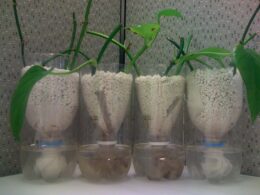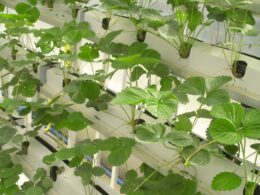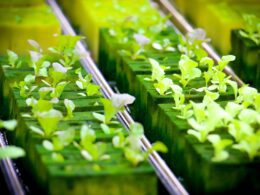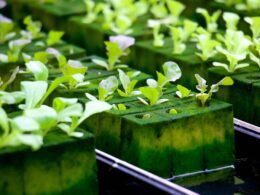If you’re new to hydroponic gardening, you may be wondering how long your plants will grow. The answer, of course, depends on a variety of factors, from the specific type of plant you’re growing to the nutrients and lighting you provide. But don’t worry, with a little knowledge and some careful attention, you can help your hydroponic plants reach their full growth potential.
In this article, we’ll explore the key factors that affect hydroponic plant growth, including water quality, pH levels, and temperature. We’ll also discuss growth rates and how to maximize them, as well as common challenges you may encounter along the way.
By the end, you’ll have a solid understanding of how long your hydroponic plants will grow and what you can do to help them thrive. So let’s get started!
Factors that Affect Hydroponic Plant Growth
Factors that impact the growth of plants in a hydroponic system include lighting, nutrients, temperature, pH levels, and airflow. The intensity of light is crucial in ensuring that your hydroponic plants grow to their full potential. A light that’s too dim or too bright can cause stunted growth or even damage to your plants. It’s important to find the right balance and maintain consistent lighting intensity throughout the day.
Another factor that affects hydroponic plant growth is the nutrient solution. The solution should contain the necessary nutrients for the specific type of plant you’re growing. Providing the right amount of nutrients is essential in promoting healthy growth. It’s important to regularly check and adjust the nutrient solution to ensure that your plants are receiving the right amount of nutrients.
In addition to lighting and nutrients, maintaining the proper temperature and pH levels is also important for the growth of hydroponic plants. The ideal temperature range for most plants is between 65-75°F. The pH level should be monitored and adjusted accordingly, as plants require different levels of acidity or alkalinity to thrive.
By ensuring that these factors are properly maintained, you can help ensure that your hydroponic plants grow to their fullest potential.
Understanding Growth Rates
You’ll be amazed at how quickly your hydroponic garden can flourish once you understand the key factors that contribute to plant growth rates.
Comparing growth rates between soil and hydroponic plants, the latter can grow up to 50% faster because they have access to all the necessary nutrients. Hydroponic plants don’t have to expend energy searching for nutrients like soil plants do, so they can focus solely on growing.
Ideal growing conditions are also important for maximizing growth rates in hydroponic plants. The temperature, humidity, and light levels should be optimized for the specific plant species you’re growing. For example, lettuce grows best in cooler temperatures around 60-70°F, while tomatoes prefer slightly warmer temperatures around 70-80°F.
To further optimize growth rates, ensure that the pH level of your hydroponic system is within the appropriate range for the plants you’re growing. Most plants prefer a pH range of 5.5-6.5, but this can vary depending on the plant. Additionally, regularly monitor your nutrient solution levels and adjust accordingly. Too much or too little of certain nutrients can stunt growth or even kill your plants.
By understanding growth rates and ideal growing conditions, you can maximize the potential of your hydroponic garden. With a little bit of knowledge and effort, you can quickly grow healthy and thriving plants right in your own home.
Tips for Maximizing Growth
To truly optimize the growth of your indoor garden, it’s crucial to implement the tips provided in this section for maximum success. One key factor is ensuring your plants receive the proper lighting. If natural light is not sufficient, consider investing in indoor lighting specifically designed for plant growth. LED lights are a great option as they emit the right spectrum of light for photosynthesis. Remember to adjust the height of your lights as your plants grow to prevent burning.
Another important factor is providing your plants with the right nutrient solutions. Hydroponic plants rely on these solutions to grow, so it’s important to monitor and adjust them as needed. Keep in mind that different plants have different nutrient requirements, so research the specific needs of your plants and adjust accordingly. Additionally, make sure to regularly clean and maintain your hydroponic system to prevent any build-up of algae or other harmful bacteria.
In addition to proper lighting and nutrient solutions, there are other ways to maximize growth in your hydroponic garden. Providing adequate air circulation and humidity levels can help prevent mold and other issues that can hinder plant growth. Additionally, pruning your plants can encourage healthy growth and prevent overcrowding. Remember to monitor your plants regularly and make adjustments as needed to ensure they are thriving in their indoor environment.
| Tips for Maximizing Growth | Benefits |
|---|---|
| Provide proper lighting | Stimulates photosynthesis |
| Adjust nutrient solutions | Provides essential nutrients |
| Maintain air circulation and humidity | Prevents mold and other issues |
| Prune plants regularly | Encourages healthy growth |
Remember, maximizing growth in your hydroponic garden requires attention to detail and consistent maintenance. By implementing these tips and monitoring your plants regularly, you can ensure that they are receiving the proper conditions to thrive and reach their full potential.
Does the Size of Hydroponically Grown Plants Differ from Soil-Grown Plants?
The size of plants growing with hydroponics compared to soil-grown plants can differ significantly. Hydroponically grown plants often exhibit faster growth rates and tend to be larger in size due to the optimized nutrient uptake and controlled growing conditions.
Common Challenges in Hydroponic Plant Growth
When growing plants hydroponically, you may face some common challenges that can affect their growth. These include disease and pest control, root rot, and pH imbalance.
To keep your plants healthy, you need to take proactive measures to prevent these issues from occurring.
Disease and Pest Control
Controlling disease and pests is crucial for ensuring optimal health and yield of your hydroponic crops. Preventative measures are the best way to manage diseases and pests. Start by keeping your hydroponic system clean and free of debris. Use a sterilizing agent to clean any equipment or tools that come in contact with your plants. This will reduce the chances of introducing harmful pathogens into your hydroponic system.
Natural remedies can also be effective in controlling diseases and pests in your hydroponic garden. Neem oil is a popular natural pesticide that can be used to control a variety of pests, including aphids, whiteflies, and spider mites. Garlic and pepper sprays can also be effective in controlling pests.
For disease control, try using compost tea or other organic fungicides. By taking preventative measures and using natural remedies, you can ensure that your hydroponic plants stay healthy and productive.
Root Rot
Now that you know how to prevent diseases and pests, let’s talk about another potential problem: root rot. This is a common issue that hydroponic gardeners face, but it can be easily prevented if you take the necessary steps.
To prevent root rot, it’s important to maintain proper oxygen levels in the water. This can be achieved by using an air pump and airstones to keep the water moving and aerated.
Additionally, make sure to regularly check the pH and nutrient levels in the water to ensure they’re properly balanced. If you do notice signs of root rot, such as wilting or discolored leaves, there are treatment options available.
One method is to add hydrogen peroxide to the water, which can help kill off any harmful bacteria or fungi. Alternatively, you can remove the affected plants and replant with healthy ones.
By taking these preventative measures and being proactive in treating root rot, you can ensure the longevity and health of your hydroponic plants.
pH Imbalance
Maintaining the proper pH balance in your hydroponic system is essential for ensuring healthy plant growth and preventing nutrient deficiencies. A pH imbalance can cause a range of issues including stunted growth, yellowing leaves, and even plant death.
To avoid these problems, it’s important to regularly test the pH levels of your nutrient solution and adjust accordingly. Adjusting pH can be done by adding pH up or pH down solutions to your nutrient solution.
If the pH is too high, add pH down solution in small amounts and test the pH level again. If the pH is too low, add pH up solution and test again. It’s important to make small adjustments as drastic changes can shock the plants.
By maintaining a proper pH balance, you can ensure that your plants are receiving the necessary nutrients for healthy growth and prevent nutrient deficiencies.
Conclusion and Future Outlook
So, you’re interested in the benefits of hydroponic plant growth and the future developments in hydroponic technology? Well, you’re in luck! Hydroponics offers many advantages over traditional soil-based farming, including faster growth rates, higher yields, and reduced water usage.
As technology continues to advance, we can expect even more efficient and innovative hydroponic systems to emerge, making it a promising industry for the future.
Benefits of Hydroponic Plant Growth
One advantage of cultivating plants with hydroponic systems is that they can thrive in a controlled environment, resulting in healthier and more productive growth. Hydroponic systems enable plants to grow vertically, utilizing space more efficiently while reducing the need for soil. This method also eliminates the need for pesticides and herbicides, resulting in a safer, more sustainable growing process.
Another benefit of hydroponic plant growth is the increased nutritional value of the produce. Plants grown in hydroponic systems have access to precise amounts of nutrients and water, resulting in higher quality fruits and vegetables. Additionally, hydroponic systems can be designed to produce crops year-round, providing fresh produce even in areas where traditional agriculture may not be possible.
This method of farming also reduces water usage and is less affected by weather conditions, making it a more reliable source of food production.
Future Developments in Hydroponic Technology
The future of hydroponic technology looks promising with advancements in vertical farming, indoor agriculture, automated systems, and sustainable energy sources.
Vertical farming is a new development in hydroponics that involves growing plants in a controlled environment with stacked layers of plants. This method allows for more plants to be grown in less space, making it ideal for urban areas with limited land.
Additionally, indoor agriculture is becoming more popular as it allows for year-round crop growth, regardless of weather conditions. Automated systems are also being developed to make hydroponic plant growth more efficient and cost-effective.
These systems allow for remote monitoring and control of plant growth, which reduces the need for manual labor and increases the accuracy of plant care. Finally, sustainable energy sources such as solar power and wind power are being incorporated into hydroponic systems to reduce their carbon footprint.
Overall, the future of hydroponic technology is bright, with exciting developments in vertical farming, indoor agriculture, automated systems, and sustainable energy sources. These advancements will not only make hydroponic plant growth more efficient and cost-effective but also more environmentally friendly.
Frequently Asked Questions
What are the different types of hydroponic systems and which one is best for growing certain types of plants?
Looking into hydroponic systems for growing plants? There are several types of hydroponic systems available, each with its own set of advantages and disadvantages.
Some of the most popular types include deep water culture, nutrient film technique, and drip irrigation.
When compared to traditional soil farming, hydroponic farming can offer several benefits, including faster growth rates, higher yields, and the ability to grow plants in areas with poor soil quality. Additionally, hydroponic systems allow for more precise control over the growing environment, including temperature, pH levels, and nutrient concentrations.
While each system has its own unique set of benefits, it’s important to choose the one that is best suited for the specific types of plants you plan to grow.
What are the nutritional requirements for hydroponic plants and how can they be met?
To ensure proper growth and development of hydroponic plants, it’s essential to understand their nutritional requirements. Hydroponic nutrient solutions play a vital role in providing plants with the necessary nutrients for their growth stages.
The composition and adjustments of these solutions are crucial to maintain the right balance of nutrients, including nitrogen, phosphorus, and potassium. Additionally, pH management for hydroponic plants is critical, as it affects nutrient uptake and overall plant health. It’s important to monitor and adjust pH levels regularly.
Hydroponic plant growth stages include germination and transplanting techniques, which require specific nutrient ratios and pH levels. By providing the right nutrients and pH levels throughout the growth stages, you can ensure healthy and robust hydroponic plants.
How often should the water and nutrient solution be changed in a hydroponic system?
To keep your hydroponic plants healthy and thriving, you need to pay close attention to the frequency of nutrient changes and the quality of the water you use.
In general, you should change the nutrient solution every two weeks to ensure that your plants are getting all the nutrients they need to grow.
If you wait too long to change the solution, the nutrient levels can become imbalanced, which can stunt plant growth or even cause them to die.
Additionally, it’s important to use high-quality water in your hydroponic system, as poor water quality can also impact plant growth.
Make sure you test the pH and nutrient levels of your water regularly to ensure that your plants are getting the best possible growing environment.
By staying on top of these factors, you can help your hydroponic plants reach their full potential and produce a bountiful harvest.
Can hydroponic plants be grown without artificial lighting, and if so, what are the limitations?
Looking for natural lighting alternatives for your hydroponic plants?
While it’s possible to grow hydroponic plants without artificial lighting, there are some growth rate limitations to keep in mind.
The amount and quality of natural light available will affect the growth rate of your plants, and may not be sufficient for some species to thrive.
Additionally, natural lighting may not provide consistent light levels throughout the day, which can also impact plant growth.
If you’re committed to using natural lighting, be sure to choose species that are suited for your specific lighting conditions and adjust your expectations for growth accordingly.
What are some common pests and diseases that affect hydroponic plants, and how can they be prevented or treated?
To keep your hydroponic plants healthy, it’s important to be aware of common pests and diseases. Two of the most common issues are fungus gnats and powdery mildew.
To prevent fungus gnats, make sure to keep your growing area clean and dry, and avoid overwatering. You can also use sticky traps or beneficial nematodes to control them.
Powdery mildew, on the other hand, thrives in humid conditions, so it’s important to maintain good ventilation and keep humidity levels low. You can also use a fungicide or a mixture of baking soda and water to control it.
By taking these preventative measures, you can ensure that your hydroponic plants stay healthy and thrive.
Conclusion
So, now you know how long hydroponic plants grow and what factors affect their growth. By providing the right nutrients, pH levels, and lighting, you can maximize their growth and yield.
Remember to monitor your plants regularly and adjust their environment as needed. Although hydroponic gardening may present some challenges, such as root rot or inadequate lighting, the benefits are worth it.
Not only can you grow plants faster and with less water, but you can also grow them year-round and in small spaces. With the right knowledge and tools, hydroponic gardening can be a rewarding and sustainable way to grow your own fresh produce.









